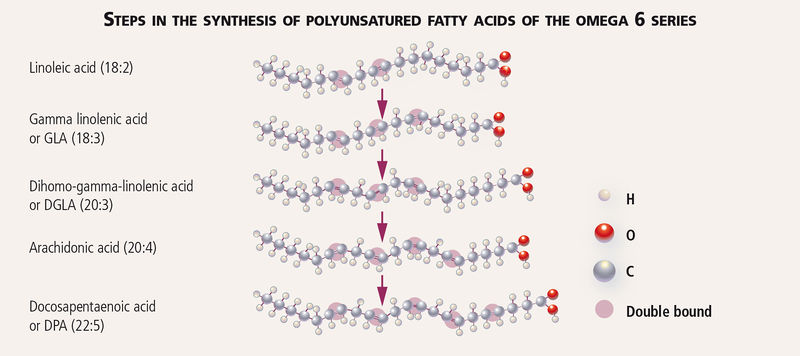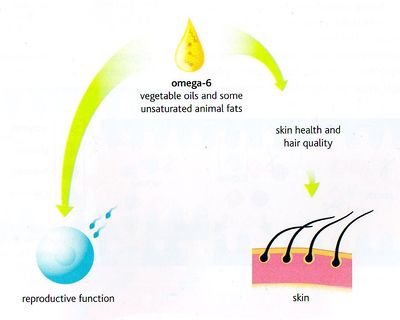Difference between revisions of "Omega-6 Fatty Acids - Nutrition"
| (3 intermediate revisions by the same user not shown) | |||
| Line 10: | Line 10: | ||
==Roles in the Body== | ==Roles in the Body== | ||
#'''Skin and Hair Coat:''' Epidermal keratinocytes secrete the LA-enriched phospholipid, ceramide, in both dogs and cats. Ceramide functions to enhance cell cohesion and create an effective water barrier<ref name="Elias"/>. Increased intake of LA above the minimal requirement may improve skin and coat health in dogs and cats<ref name="Rees"/><ref name="Codner"/>. | #'''Skin and Hair Coat:''' Epidermal keratinocytes secrete the LA-enriched phospholipid, ceramide, in both dogs and cats. Ceramide functions to enhance cell cohesion and create an effective water barrier<ref name="Elias"/>. Increased intake of LA above the minimal requirement may improve skin and coat health in dogs and cats<ref name="Rees"/><ref name="Codner"/>. | ||
| − | #'''Inflammation:''' Arachidonic acid comprises approximately 20-25% of the fatty acids within the cellular membrane and acts as a substrate for cyclooxygenase (COX) and lipoxygenase (LOX) enzymes to form the inflammatory [[Nutrition Glossary#Eicosanoids|eicosanoids]] series-2 prostaglandins (prostaglandins, prostycyclins and thromboxanes) and series-4 leukotrienes<ref name="NRC"/>. | + | #'''[[Inflammation]]:''' Arachidonic acid comprises approximately 20-25% of the fatty acids within the cellular membrane and acts as a substrate for cyclooxygenase (COX) and lipoxygenase (LOX) enzymes to form the inflammatory [[Nutrition Glossary#Eicosanoids|eicosanoids]] series-2 prostaglandins (prostaglandins, prostycyclins and thromboxanes) and series-4 leukotrienes<ref name="NRC"/>. |
#'''Reproduction:''' Queens fed AA deficient diets with adequate levels of LA are unable to support normal [[Pregnancy|pregnancy]] and foetal development<ref name="MacDonald">MacDonald ML, et al. Effects of linoleate and arachidonate deficiency on reproduction and spermatogenesis in the cat. J Nutr 1984;114:719-726.</ref>, while no impact on male fertility and [[Spermatogenesis and Spermiation - Anatomy & Physiology|spermatogenesis]] is seen. | #'''Reproduction:''' Queens fed AA deficient diets with adequate levels of LA are unable to support normal [[Pregnancy|pregnancy]] and foetal development<ref name="MacDonald">MacDonald ML, et al. Effects of linoleate and arachidonate deficiency on reproduction and spermatogenesis in the cat. J Nutr 1984;114:719-726.</ref>, while no impact on male fertility and [[Spermatogenesis and Spermiation - Anatomy & Physiology|spermatogenesis]] is seen. | ||
<br> | <br> | ||
| − | [[File:Omega 6.jpg|thumb|400px|center|Role of omega-6 fatty acids in the body | + | [[File:Omega 6.jpg|thumb|400px|center|Role of omega-6 fatty acids in the body]] |
==Consequences of Omega-6 Fatty Acid Deficiency== | ==Consequences of Omega-6 Fatty Acid Deficiency== | ||
| Line 31: | Line 31: | ||
==References== | ==References== | ||
<references/> | <references/> | ||
| + | |||
| + | <br> | ||
| + | {{Reviewed Nutrition 1 | ||
| + | |date = 19 May 2015}} | ||
| + | {{Waltham}} | ||
| + | {{OpenPages}} | ||
| + | |||
[[Category:Fatty Acids]] | [[Category:Fatty Acids]] | ||
| − | |||
| − | |||
Latest revision as of 08:33, 11 May 2016
What are Omega-6 Fatty Acids?
Omega-6 fatty acids are a family of polyunsaturated straight-chain hydrocarbons that have a double bond in the sixth carbon-carbon bond (n-6) when counted from the methyl end of the molecule. Linoleic acid contains 18 carbons with double bonds at both the n-6 and n-9 positions (written as 18:2n-6). It undergoes further desaturation by hepatic Δ-6 desaturase to form gamma-linolenic acid (GLA; 18:3n-6), which is elongated and desaturated once more to form arachidonic acid (AA; 20:4n-6). Linoleic acid (LA) is considered an essential fatty acid in both dogs and cats. Dogs are able to convert adequate amounts of LA to AA to meet requirements at all life-stages[1], cats however have limited hepatic Δ-6 desaturase enzyme activity[2][3][4] and require a dietary source of AA to meet their metabolic needs. The dietary requirement for LA in cats is lower than dogs because LA is not used as a precursor for synthesis of AA.
Why are they Important?
Linoleic acid is concentrated in the skin and hair coat of cats and dogs to form the normal water permeable barrier of the epidermis[5]. Arachidonic acid is incorporated into the lipid bilayer of all cell membranes; it serves both as a structural component of cell walls and a precursor to normal inflammatory mediators[6]. Increased intake of LA above the minimal requirement may help improve skin and coat quality in dogs and cats[7][8]. Modification of AA intake in relation to specific omega-3 fatty acids has been suggested as an aid in the management of inflammatory condition (such as allergic dermatitis, nephritis, or inflammatory bowel disease) in dogs and cats[9]. Omega-6 and omega-3 fatty acids compete for the same metabolic enzymes; as such the total amount as well as the ratio of omega-6 to omega-3 fatty acids is an important consideration when evaluating dietary balance or when attempting to modify concentrations of these nutrients for health and disease management.
Roles in the Body
- Skin and Hair Coat: Epidermal keratinocytes secrete the LA-enriched phospholipid, ceramide, in both dogs and cats. Ceramide functions to enhance cell cohesion and create an effective water barrier[5]. Increased intake of LA above the minimal requirement may improve skin and coat health in dogs and cats[7][8].
- Inflammation: Arachidonic acid comprises approximately 20-25% of the fatty acids within the cellular membrane and acts as a substrate for cyclooxygenase (COX) and lipoxygenase (LOX) enzymes to form the inflammatory eicosanoids series-2 prostaglandins (prostaglandins, prostycyclins and thromboxanes) and series-4 leukotrienes[6].
- Reproduction: Queens fed AA deficient diets with adequate levels of LA are unable to support normal pregnancy and foetal development[10], while no impact on male fertility and spermatogenesis is seen.
Consequences of Omega-6 Fatty Acid Deficiency
- Growth: Kittens fed LA deficient diets fail to grow normally and develop course dull hair coats[2][3]. Puppies fed a LA deficient diet developed coarse, dry hair coats with skin flaking after 2 months[11].
- Maintenance: When fed a LA deficient diet, increased endogenous production of oleic acid (18:1n-9) occurs[12]. Oleic acid is incorporated into ceramide in place of the missing LA, but is less effective at maintaining cell cohesion. Thickening of the epidermis and cellular swelling occur, and the thickened more loosely packed keratinocytes slough readily resulting in the clinical appearance of scaling[13]. The greasy, flaky skin is prone to secondary infection and pyoderma occurs commonly with LA deficiencies[8][14]. Interdigital exudation and otitis externa are also sequelae of LA deficiencies in dogs[15]. There are no clinical signs reported with AA deficiency in adult, non-reproductive cats.
- Reproduction: Linoleic acid deficiency does not appear to impact reproduction in dogs and cats, but AA deficiency in queens does not support normal pregnancy or foetal development[10]. Queens fed AA deficient diets from weaning will have normal heat cycles and may have a single litters of kittens, but are unable to support further pregnancies.
Toxicity
There is speculation that increased intake of omega-6 fatty acids with inadequate omega-3 fatty acids intake may promote a pro-inflammatory state[9], but research evidence to support this is lacking in dogs and cats.
Dietary Sources
Depending on what is fed during production, animal fats (associated with muscle meat, organ meat, and eggs) have varying LA concentrations; animal fats are good sources of AA. Seed and seed oils are more consistent sources of LA. Corn, soy and cottonseed oils have the highest concentrations of LA (approximately 50% of the total fat), while other seed oils are must lower such as flaxseed at 12% LA. Many seed oil crops are also being modified for human health concerns and even those with historically higher levels of LA are being modified to produce less LA and more oleic acid or alpha-linolenic acid[16]. Sunflower oil is an example of this genetic modification. Sunflower oil naturally contains close to 65% linoleic acid content but new genetically modified strains are high in oleic acid with only 3% linoleic acid[17]. Commercial pet food companies monitor levels of essential omega-6 fatty acids in source ingredients, but care must be taken when selecting essential fatty acid sources for home-prepared diets.
Diagnosing Omega-6 Fatty Acid Deficiency
Diagnosis based on compatible clinical signs of LA deficiency and evaluation of diet. Plasma lipid profiles can also be used to diagnose LA deficiencies; increased concentrations of the omega-9 fatty acid oleic acid (18:1n-9) are also seen with LA deficiency. Arachidonic acid deficiency in reproductive queens is difficult to determine and often relies on evaluation of diet.
References
- ↑ Dunbar BL and Bauer JE. Conversion of essential fatty acids by delta-6 desaturase enzyme in dog liver microsomes. J Nutr 2000;132:1701S-1703S.
- ↑ 2.0 2.1 Sinclair AJ, et al. Essential fatty acid deficiency and evidence for arachidonate synthesis in the cat. Br J Nutr 1981;46:93-93.
- ↑ 3.0 3.1 Rivers JPW. Essential fatty acids in cats. J Small Anim Prac 1982;23:563-576.
- ↑ Bauer JE. Fatty acid metabolism in domestic cats (Felis catus) and cheetahs (Acononyx jubatus). Proc Nat Soc 1997;56:1013-1024.
- ↑ 5.0 5.1 Elias PM, et al. The permeability barrier in essential fatty acid deficiency: Evidence for a direct role of linoleic acid in barrier function. J Invest Dermatol 1980;74:230-233.
- ↑ 6.0 6.1 National Research Council (NRC). Fat and Fatty Acids In Nutrient Requirements for Dogs and Cats. 2006 Washington, DC: National Academies Press p.81-110.
- ↑ 7.0 7.1 Rees CA, et al. Effects of dietary fatty flaxseed and sunflower seed supplementation on normal canine serum polyunsaturated fatty acids and skin and hair condition scores. Vet Derm 2001;12:111-117.
- ↑ 8.0 8.1 8.2 Codner EC and Thatcher CD. The role of nutrition in the management of dermatoses. Semin Vet Med Surg (Sm Anim) 1990;5:167-177.
- ↑ 9.0 9.1 Raphael W and Sordillo LM. Dietary Polyunsaturated Fatty Acids and Inflammation: The Role of Phospholipid Biosynthesis. Int J Mol Sci 2013;14:21167-21188.
- ↑ 10.0 10.1 MacDonald ML, et al. Effects of linoleate and arachidonate deficiency on reproduction and spermatogenesis in the cat. J Nutr 1984;114:719-726.
- ↑ Weise HF, et al. Influence of High and Low Caloric Intakes on Fat Deficiency of Dogs. J Nutr 1962;76:71-81.
- ↑ Spector AA. Lipid metabolism: essential fatty acids. In Biochemical and Physiologic Principles of Human Nutrition. First edition. 2000 Philadelphia, PA: WB Sunders p373.
- ↑ Hansen AE, et al. Sequence of histological change in skin of dogs in relation to dietary fat. J Nutr 1954;52:541-554.
- ↑ Hansen AE, et al. Susceptibility to infection manifested by dog on low fat diet. Fed Proc 1948;7:289.
- ↑ Hansen AE and Weise HF. Fat in the diet and relation to nutrition of the dog. I. Characteristic appearance and gross changes of animals fed diets with and without fat. Tex Rep Biol Med 1951;9:491-515.
- ↑ Damude HG and Kinney AJ. Enhancing Plant Seed Oils for Human Nutrition. Plant Physiol 2008;147:962-968.
- ↑ Lacombe S, et al. An insertion of oleate desaturase homologous sequence silences via siRNA the functional gene leading to high oleic acid content in sunflower seed oil. Mol Genet Genomics 2009;281:43-54.
| This article was: Date reviewed: 19 May 2015 |
| Endorsed by WALTHAM®, a leading authority in companion animal nutrition and wellbeing for over 50 years and the science institute for Mars Petcare. |
Error in widget FBRecommend: unable to write file /var/www/wikivet.net/extensions/Widgets/compiled_templates/wrt6936b7eb4fafc9_54813911 Error in widget google+: unable to write file /var/www/wikivet.net/extensions/Widgets/compiled_templates/wrt6936b7eb556229_66292658 Error in widget TwitterTweet: unable to write file /var/www/wikivet.net/extensions/Widgets/compiled_templates/wrt6936b7eb5adb07_63053311
|
| WikiVet® Introduction - Help WikiVet - Report a Problem |

